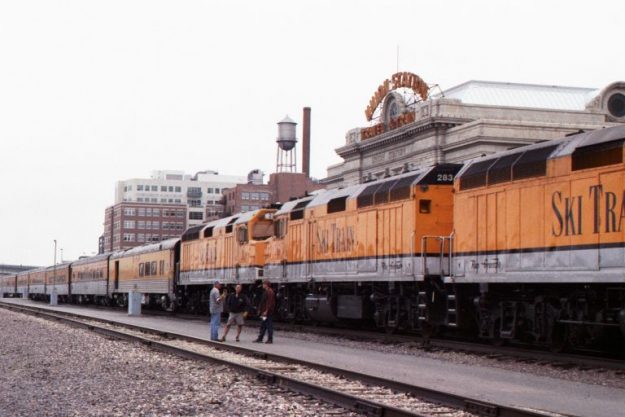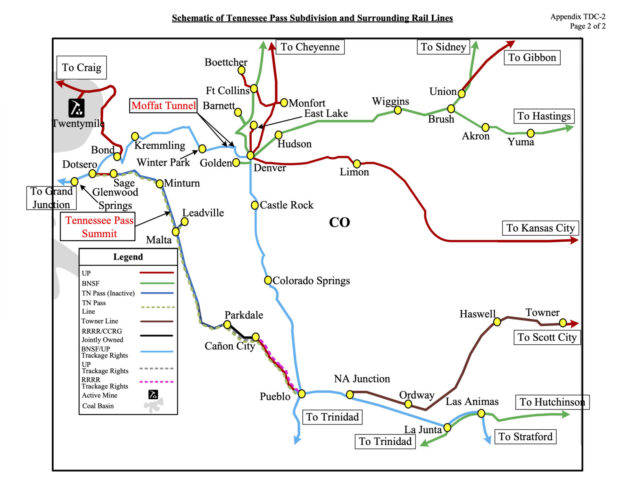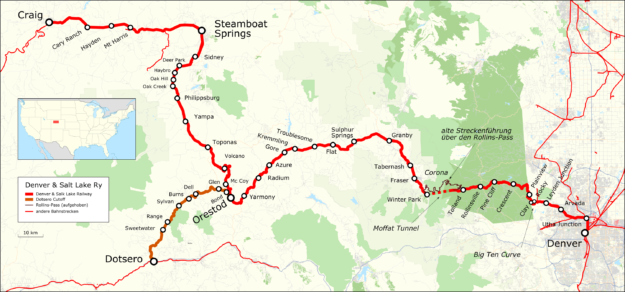Widgetized Section
Go to Admin » Appearance » Widgets » and move Gabfire Widget: Social into that MastheadOverlay zone
The O. Zone: Time for local leaders to get onboard Colorado commuter, ski train

When I saw the front-page headline of the Vail Daily on March 21 — “Mountain rail gathers steam” – I got excited. Were local leaders finally fully jumping onboard an alternative to the Interstate 70 nightmare that regularly paralyzes local, regional and interstate vehicle travel through Vail?
No. Turns out lawmakers in Denver are proposing a rental-car fee increase to help fund both Front Range Passenger Rail and an expansion/extension of Amtrak’s existing Winter Park Express ski train from Denver to Winter Park, then all the way to Steamboat Springs and Craig.
Vail Resorts’ rival Alterra Mountain Company, run by ski execs with some pretty deep Vail ties, is backing both expanded ski-train service to Winter Park and the extension of that service to Steamboat and beyond in Northwest Colorado. Alterra runs Winter Park for the city of Denver and owns Steamboat Resort outright. Both are on Alterra’s Ikon Pass, not Vail’s Epic Pass.
The northwest ski train to Craig, where many Steamboat workers live, runs right through Hayden, another bedroom community that also happens to have a rail link to Routt County’s regional airport. That’s a ski train with resort-worker-commuter potential linked to an airport – all very far from the national embarrassment I-70 has become with stories like this deeply reported piece of participatory journalism by Outside.
Backing this massive ski-train expansion are the aforementioned Alterra and Amtrak, bolstered by a big infusion of federal dollars from Amtrak Joe’s administration, the Colorado Department of Transportation (CDOT), led by an executive director who was just named to an influential federal rail regulatory committee, Routt County and a ton of other state and local officials, and, shockingly, the owner of the rail line itself, Union Pacific (to replace lost coal-train traffic).
Vail and surrounding Eagle County, meanwhile, are literally getting left behind at the station in what amounts to a Colorado ski-train, workforce-transit frenzy after years of utter inaction on the mountain-rail front. If any of it materializes in our lifetimes remains to be seen, but Union Pacific also owns a rail line right through Eagle County that they may still want to take out of play for any future freight competition by locking it up with passenger service and light freight.

Known as the Tennessee Pass Line because it goes up and over Tennessee Pass right by Lake County-owned Ski Cooper ski area, the 200-plus-mile stretch of track that’s been dormant but not abandoned since the late 90s starts in Pueblo and travels along the Arkansas River before coming our way along the headwaters of the Eagle River through Camp Hale and connecting to UP’s active Central Corridor Rail Line at Dotsero in western Eagle County.
Unlike the Central Corridor from Grand Junction through Glenwood Springs, Dotsero, Winter Park (home to the six-mile Moffat Tunnel) and down into Denver, there are no trains of any kind rumbling along the Tennessee Pass Line (TPL), especially oil-laden freight trains. That means our local line could conceivably accommodate some form of battery-powered LTR, or Light Rail Transit. And it also passes right by the Eagle County Regional Airport on its way “up valley” toward Avon, Beaver Creek and Vail.
In fact, if you look at a railroad map, the proposed Northwest Colorado ski train, which some officials say could be just years not decades away, actually swings though the northwestern corner of Eagle County near Bond before heading north toward Steamboat. From Bond to Dotsero, less than 40 miles, the active Central Corridor Line already serves Amtrak’s California Zephyr between Chicago and California’s Bay Area, although it doesn’t stop here locally.

Why, then, are we not all collectively rattling the rails for some of those federal funds to tie into a broader Colorado workforce/tourist ski-train network from our own local airport up to our ski areas with stops in bedroom communities on the way, especially one that could connect us down to Leadville, up to Steamboat, east to Denver or west to Glenwood, Grand Junction, Utah and beyond?
Here are a few of the reasons why:
- First, lack of vision and low on our priority lists, behind critical items like workforce housing, attainable homes for young professionals and desperately needed daycare. And it’s hard to see how rail will help when we are still slaves to our individual automobiles.
- Real estate interests – the same ones that frequently fight multi-family housing projects – don’t want trains suddenly reappearing after 27 years (a lot of condos have flown up along those never-abandoned tracks over the last quarter century). Vail’s Harry Frampton, who developed and saved Beaver Creek from the doldrums of the 80s and went on to redevelop Denver’s Union Station, doesn’t want the trains to come back to the TPL.
- A ski company that owns a van service to Denver International Airport. Although Vail Resorts told me they back anything that makes it easier and safer to get the slopes, citing their support of forming the Eagle Valley Regional Transportation Authority, VR doesn’t seem quite as vociferous about trains as, say, Alterra and the Steamboat train.
- An unhealthy obsession with buses and cars. Expanding bus service is great, and thus far the prime directive of the EVRTA, but that takes drivers – drivers who need homes. And our parking requirements for new development, I argue, hamper new building projects.
- Then there’s the big one: money. Who wants to massively subsidize transportation (although we already do by funding endless, inadequate road improvements)? But now there’s a huge pot of federal funds available for rail, and if a place like Eagle County with the wealth to completely rethink its mental health system (Paradise Paradox) can’t lead on transportation — especially when getting people seamlessly to the slopes is our bread and butter – what can we do going forward? Accept the status quo of endless gridlock?
Meanwhile, all the leadership on these issues seems to be at the state level, with the administration of Gov. Jared Polis bent on incentivizing multi-family housing development near rail and bus stations while the legislature simultaneously works toward increased rail safety in the wake of deadly derailments in Colorado and around the country. The Railroad Safety Requirement (HB24-1030) bill is headed to third reading in House, and this follows hard on the heels of a new two-person crew Federal Railroad Administration rule for freight trains.
Finally, reactivating the TPL and planning for a wider statewide network could solve a big political problem for Front Range Passenger Rail: Southern Colorado feeling left out as the early phases rightly focus on connecting Denver to Fort Collins via Boulder and then the ready-to-roll mountain route to Craig. As early as this November, the FRPR may ask for up to a half-cent sales tax to fund rail, and the 13-county taxing district along the I-25 corridor extends south down to Colorado Springs and Pueblo, where, once again, they’re watching as the goodies go up north first.
A plan for a clear connection from southern Colorado up to the mountains might add more energy to ultimately connecting Pueblo and Colorado Spring to Trinidad, where our state’s other long-distance Amtrak line, the Southwest Chief, cuts through the southeastern corner of the state on its way from Chicago to Los Angeles. Then you would have two major east-west interstate routes connecting in Colorado with transfers between our Western Slope and Front Range.
And the number of ski areas within shouting distance of a railroad station would jump from just the Alterra resorts of Winter Park and Steamboat to include the Vail Resorts’ ski areas of Vail and Beaver Creek and several independents such as Ski Cooper, Monarch and Ski Sunlight – a true ski-train network that would no doubt be a massive international tourism draw.
At the far western end of that network (think Powderhorn) would be another major airport in a city that already has active rail service but also feels left out of the Denver power circles: Grand Junction. Mayor Anna Stout told me her city suffers from “geographic inequity” – a factor she says makes it difficult to move west to east: “We really have not invested significantly in our transportation infrastructure in this country in many decades. We’re feeling the pinch over here in western Colorado because of it, and in southern Colorado as well.”
Local leaders across the state should be coming together now to advocate for their share of Colorado’s rail-renaissance pie. Yes, a Euro-style ski train with high-end sleeper cars would be an obvious boon, but the bigger benefit would be workforce housing connections, taking cars off our overburdened roads, and dramatically reduced carbon pollution for our outdoor lifestyle.
Editor’s note: Editor’s note: The O. Zone is a recurring opinion column by RealVail.com publisher David O. Williams. The Railroad Safety Requirement (HB24-1030) bill passed out of the Colorado House on third and final reading by a margin of 43-12 on Friday and now heads to the state Senate for consideration.


